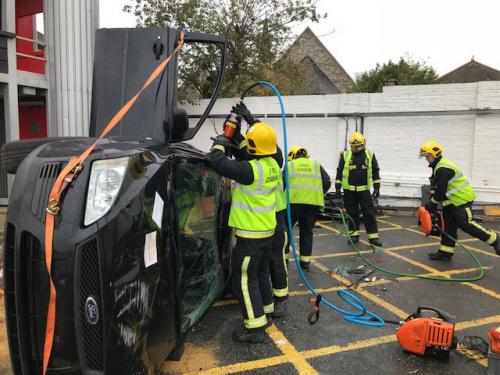Vehicle on its Side: Extrication Options
A vehicle resting on its side following a collision is not an uncommon occurrence and crews should be familiar with the options they have with which to extricate the occupant(s).
Fewer options
When we are faced with a vehicle on its wheels, we generally have a multitude of options for access, space creation and full access. We will have a choice of doors (or windows) to enter, many space creation options and more than one way of relocating the roof if required. When a vehicle comes to rest on its side however, our choices are severely limited which, in my opinion, is an advantage. You see, sometimes the fewer options you have, the easier the extrication is to resolve. A recent question I received on Twitter regarding extrication from a vehicle on its side has led me to blog about this particular topic as whilst our options to gain access and create space are limited, there are some considerations and tips to discuss.
Consideratons
- Firstly, a car on its side may have rolled several times which should raise your index of suspicion when considering occupant injuries, especially if they have been unbelted. This will mean that early access to a trapped patient is crucial to ensure that time critical medical interventions can be delivered e.g. maintaining an airway.
- Stability is compromised, especially if on uneven ground and the vehicle must be stabilised in such a way that it does not compromise your access or interfere with your space creation plan.
- From a safety perspective, fuel, coolant and other liquids are more prone to leak and the catalytic converter (on certain vehicles) is exposed, introducing risk of thermal injury.
- Access is predominantly going to focus around the rear of the vehicle (rear hatch or screen) and your only real ultimate access option is to flap the roof down. This entails cutting all of the A,B and C pillars (also D pillars if applicable)
This last point is what the question I received on Twitter related to. In the picture below you can see that the door is held in the open position; the question was "why?".

Skip the glass management
Well if the doors were in the closed position, this would require the glass in the doors to be managed. That is to say that it would either have to be broken or covered with a film product (e.g. Packexe). Managing the ‘upper’ glass in a car on its side means that glass can fall into the passenger compartment and possible onto the patient and medic inside the vehicle. By opening the doors the posts can be cut with no need for removing the glass. In the pic it is held open with a ratchet strap, but it is also possible for a crew member to hold the door open while the cuts are made and then close the doors once completed. The advantage here, is that the patient and medic are still protected from the environment.
It is only a small point but it makes the process of flapping the roof down far more simple and negates the need to manage the glass above a patient.
As ever, I welcome your comments!
Ian Dunbar